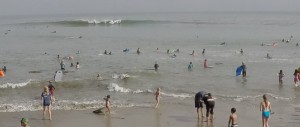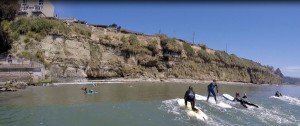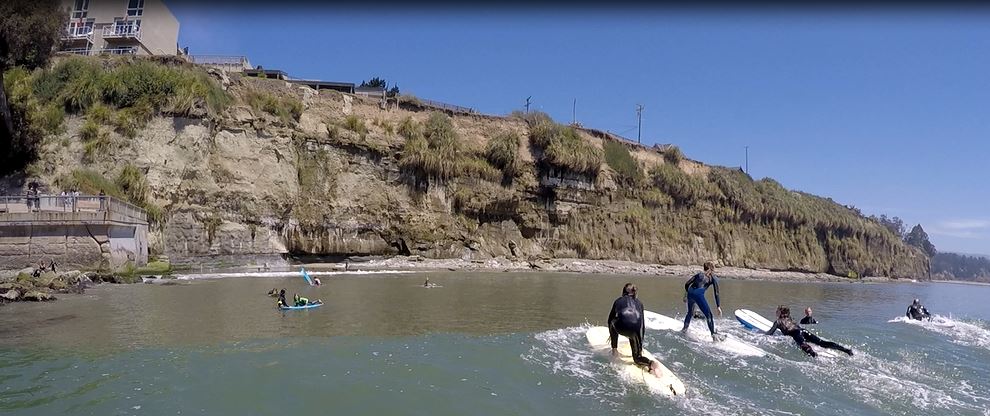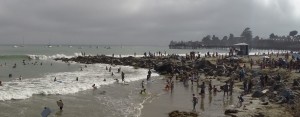Capitola, Surf & Stand Up Paddle Boarding
Ocean Safety for the Beginner Santa Cruz Surfer
When planning your day surfing Santa Cruz, or when considering Santa Cruz surf lessons, place ocean safety at the top of your list. Surfing is a very demanding sport and knowing what the day has in store can make sure you stay safe. Santa Cruz surfing offers ever-changing and often unpredictable environmental conditions. With the proper knowledge, planning and experience surfing Santa Cruz can be very safe and fun. When you take a lesson, your surf instructor will help keep you safe and teach you what to look for. If considering going out on your own, give us a call (or any Santa Cruz surf shop) to get up-to-date wave and weather information. Also, Su rfline ( see widget to the right) can give you a lot of information on most all of the Santa Cruz surfing spots. Bottom line – don’t go out before you know what the day and ocean has in store!
rfline ( see widget to the right) can give you a lot of information on most all of the Santa Cruz surfing spots. Bottom line – don’t go out before you know what the day and ocean has in store!
Below are some ocean safety factors you should take into account on your next time you go paddle boarding Santa Cruz waters or surfing Santa Cruz surf breaks.
- The Weather
Weather conditions can change at a moment’s notice. Wind directions can change in an instant. Stay aware of changes in the weather. Stay up to date on the local weather forecast. Check out the Surfline information to the right to get information about any local Santa Cruz surfing spot.
- The Waves
Be sure to first choose a surf break that matches your surfing ability. If you’re beginning surfer you do not want to attempt to surf an advanced break. Take some time to make sure the wave size and conditions are within your comfort level. There are times when a large swell can turn a beginner break into something that is beyond your ability. Take the time before you paddle out to make sure your beginner break has the beginner waves to match your ability. Read more about Santa Cruz surfing breaks.
- Ocean Currents
There are two types of currents. There are longshore and rip currents. It is very important to educate yourself on how rip currents and longshore currents work. These currents can sweep small kids and the unaware beach goers down the beach or out to sea very quickly. It’s important to be able to identify these currents and a know how to avoid them. Please visit NOAA to learn more.
- Shoreline Features
The shoreline landscape is an important consideration. Take time check out the landscape of the area you are preparing to surf. Look for a safe way for you to enter and exit the surf such as a sandy beach area with minimal wave action. Avoid entry and exit from areas with rocks and breaking waves.
- Rocks and boulders
Some surf breaks may have submerged rocks or boulders depending on the tides. A high tide can hide these hazards. It’s a smart to talk to an on duty lifeguard or other surfers to find out where these hazards are located. Areas such as Pleasure Point and Steamer Lane have very little sandy beach area and more exposed slippery rocks.
- Cliffs
Some waves may break next to or in front of a cliff. Cliffs, at a high tide, make it difficult to exit the water. Make sure to make yourself aware of any currents. If you’re toying with the idea of surfing at a surfing break where the waves crash close to a cliff, take time to observe the conditions to make sure you will be safe. Capitola, Steamer Lane and Pleasure Point are examples of surf breaks that have cliffs that you need to be careful of at higher tides.
Jetties are piles of rocks that extend out into the ocean. Jetties can be dangerous if you fall off your surfboard or get pushed against the rocks by the waves. Keep your distance. Capitola has 2 jetties to be aware of. Make sure you know where each of them are so you can be sure to avoid them the next time you paddle out.
- Other Surfers
Large crowds of people at a break can be a hazard. Boards and bodies can be going in every direction. With large crowds it’s very important to follow proper surfing etiquette.
Make yourself aware of surfing etiquette. These rules will make your next surfing session a much safer and enjoyable experience.
- Swimming Ability
The ability to swim is an absolute must. But knowing how to swim is just the beginning when it comes to ocean safety. Just because you can swim or tread water in a swimming pool does not give you the experience you will need in the ocean. The ocean is unpredictable. The water can be cold and even the smallest waves can be extremely powerful. These are factors that the beginner surfer need take into consideration. If you have any concerns about abilities, take a lesson or choose a beginner shallow spot.


